Wireless Africa Home Page: Difference between revisions
| (78 intermediate revisions by 3 users not shown) | |||
| Line 10: | Line 10: | ||
|} | |} | ||
== 1 May 2007 Wireless Africa roadmap process underway == | == 25,26 August 2009 - Meraka mesh lab workshop == | ||
A 2 day training workshop was help at Meraka to introduce graduate students to all the features and tools in the 49 node mesh grid that is installed at Meraka. Our own students as well as students from Rhodes and University of the North West attended the workshop. Some students will now be using the lab to carry out their masters and PhD research and this workshop has eased the steep learning curve required before useful experiments can be run. | |||
Download content of tutorial [http://wirelessafrica.meraka.org.za/wiki/index.php/49-node_Indoor_Mesh#Workshop_notes_from_workshop_held_in_August_2009 here] | |||
== 1 July 2009 - Meraka mesh lab server upgraded and new manual released == | |||
A more stable mesh lab server with 1 TB of storage capacity running the Ubuntu LTS (Linux Terminal Server) project hardy release was unveiled. This has greatly increased the reliability of the server and some new Ubuntu OS images containing the MIT click router software has also been installed to run on all the nodes in the lab. | |||
A new lab manual which has full instructions detailing how to build such a server is available [http://wirelessafrica.meraka.org.za/wiki/index.php/49-node_Indoor_Mesh#Manuals_now_available here] | |||
== 27 August 2008 - Research collaboration on wireless technology with Hungarian University == | |||
The Meraka Institute of the CSIR recently had a visit by a team of Hungarian researchers from the Institute of Informatics at the University of Szeged. The visit has given strong impetus to collaboration between Hungary and South Africa on a research project in the domain of wireless mesh networks (WMN) for rural areas. | |||
Read article [http://www.csir.co.za/enews/2008_aug/ic_06.html here] | |||
== 19 August 2008 - Researcher awarded scholarship to pursue PhD == | |||
An exceptional offer to work on a PhD by the prestigious University of Santa Barbara has seen a talented young researcher of the Meraka Institute at the CSIR leave for a five-year stint. David Johnson was accepted as one of the few "top-notch applications with excellent potential for doctoral work" among a total of over 300 highly-qualified applicants; he has also been granted five years of guaranteed financial support. | |||
David was awarded an MEng (cum laude) last year for his work on performance analysis of mesh networking protocols on the Meraka Institute's indoor mesh test bed. He is well known in South Africa and is starting to be recognised in international research circles for his work on wireless mesh networks (WMN). He was instrumental in the establishment of the Peebles Valley Mesh Network, which showcased the use of the innovative 'cantenna', a tin used as a low-cost antenna in the context of community mesh networks. | |||
Read article [http://www.csir.co.za/enews/2008_aug/ic_03.html here] | |||
== 24-27 June 2008 - Wireless Africa workshop == | |||
Wireless Africa, a unique pan-African initiative led by the Meraka Institute of the CSIR, has named three reference sites (in Nigeria, Ghana and Uganda) to lead the first phase of the project in setting up and studying community-owned information networks to benefit poor and rural African people. | |||
Funded by the Canadian International Development Research Centre (IDRC) for a period of two years, the Wireless Africa initiative is a collaborative research and development (R&D)project to study, validate and enhance business models that achieve economic sustainability of wireless infrastructure in rural and remote areas. | |||
Read article [http://www.csir.co.za/enews/2008_aug/ic_09.html here] | |||
== 23 February 2008 - Wireless community linkup == | |||
[[Image:Linkup.png|thumb|180px|Linkup meeting]] | |||
Linkup is an event designed to help people meet other people from other Wireless Groups, see what they have in common, share their knowledge and experiences and see if they can collaborate. | |||
The following agenda is planned: | |||
* Background on the WUGS and on the Meraka Institute | |||
* Guest talk from Elektra Aichele from Freifunk talking about the wireless community network in Berlin | |||
* Explore collaboration | |||
'''Place''': Building 53, Dept Science and Technology, CSIR Campus, Pretoria | |||
'''Date''': 23 February | |||
'''Time''': 9:30 AM - 13:00 AM | |||
'''Contact''': kmf@fischer.org.za | |||
Presentations made by Meraka can be found here: | |||
[[Media:Linkup-meraka-short.pdf | Overview of mesh networking at Meraka]] | |||
[[Media:olsr-thomas-elektra.pdf | OLSR and beyond]] | |||
[[Media:Freifunk-presentation.pdf | Overview Freifunk mesh network]] | |||
== 2 November 2007 - Building a Rural Wireless Mesh Network DIY Guide released == | |||
[[Image:DIY Guide_Cover_sml.png|thumb|180px|DIY Mesh Guide]] | |||
"Reliable, affordable and easy access to telecommunication services for all has been identified as key to social and economic development in Africa. Self-provisioning and community ownership of low cost, distributed infrastructure is becoming a viable alternative to increase the penetration of telecommunication services in rural Africa. The recent emergence of wireless mesh network technology (based on IEEE 802.11 a/b/g standards) can help to improve the delivery of telecommunication services in these regions." | |||
The guide tries to simplfy the planning and building of a mesh network, using a step-by-step approach to setting up a infrastructure mesh node, or an access point using a Linksys WRT54gl and the Freifunk firmware or DD WRT firmware depending on the node type. | |||
A pre-release version of the DIY mesh guide is now available. We invite researchers, wireless network implementors and communities to review the guide and provide us with feedback. | |||
Access the [[DIY_Mesh_Guide|'''DIY Mesh Guide''']] | |||
<br clear=all> | |||
== October 2007 - Wireless Africa featured in African Communications == | |||
"The Challenge of providing wireless connectivity across Africa is about researching the ways and means to develop sustainable informations and communications technology in developing countries..." | |||
Read the full article [[Media:AfricanCommunications2007_10_01_8c64e.pdf|download a .pdf of the article]] (177Kb) | |||
<br clear=all> | |||
== 25 October 2007 - Wireless Africa appears in iWeek == | |||
[[Image:WA_iWeek Cover_Issue121.jpg|thumb|180px|Wireless Africa appears in iWeek, Issue #121]] | |||
The CSIR's Wireless Africa project begins to make strides into mesh networking know-how that could help connect Africa's 850 million unconnected. | |||
Africa has some 850 million broadband-unconnected people, and it is with these masses in mind that the CSIR launched its Wireless Africa project a few years ago. | |||
Read the full article online at [http://www.iweek.co.za/ViewStory.asp?StoryID=178758 '''iWeek: First inch in the last mile'''] | |||
or [[Media:2007-10-25 iWeek article.pdf|download a .pdf of the article]] (1.1Mb) | |||
<br clear=all> | |||
== 17 August 2007 - Meraka Institute signs MoU with LinkNet of Zambia == | |||
[[Image: Signing_of_MoU_between_Meraka_and_LinkNet.jpg |thumb|(Front) Phil Hendricks (CSIR) and Gertjan van Stam (LinkNet) after the signing of the MoU <br>(Back) Karel Matthee and Kobus Roux (Meraka Institute)]] | |||
The signing of a memorandum of understanding (MoU) between [http://link.net.zm LinkNet Multi-Purpose Co-operative Society Limited of Zambia] and the [http://www.meraka.org.za Meraka Institute] on 17 August 2007 is another significant step towards the creation of low-cost, wireless connectivity in Africa. LinkNet has as its objective to establish internet communication facilities in rural communities in Zambia to further holistic empowerment and capacity building of institutions and rural people. The Meraka Institute is a South African national research centre managed by the [http://www.csir.co.za CSIR]. | |||
Read full article: [[Meraka Institute signs MoU with LinkNet of Zambia]] | |||
<br clear=all> | |||
== 1 May 2007 - Wireless Africa roadmap process underway == | |||
[[Image: Rm-ws-small.jpg|thumb]] | [[Image: Rm-ws-small.jpg|thumb]] | ||
| Line 35: | Line 142: | ||
More information can be found here: '''[[ Wireless Africa Roadmap ]]'''. ''We strongly urge other researchers in the field to comment on this roadmap'' | More information can be found here: '''[[ Wireless Africa Roadmap ]]'''. ''We strongly urge other researchers in the field to comment on this roadmap'' | ||
== 10 December 2006 Prototype 1 of fully self-contained solar powered SA mesh node == | <br clear=all> | ||
== 10 December 2006 - Prototype 1 of fully self-contained solar powered SA mesh node == | |||
[[Image: Sa-mesh-node2.JPG|thumb|SA Mesh Node]] | [[Image: Sa-mesh-node2.JPG|thumb|SA Mesh Node]] | ||
| Line 43: | Line 152: | ||
[[More Information on the SA mesh node]] | [[More Information on the SA mesh node]] | ||
== 1 October 2006 Tin can connects rural home to outside world == | <br clear=all> | ||
== 1 October 2006 - Tin can connects rural home to outside world == | |||
[[Image: Cantenna-peebles-small.jpg|thumb]] | |||
The Meraka Institute's first Cantenna installed in a rural setting was successfully mounted onto the house of Agnes Mdluli, a health worker from Peebles valley, near White River in Mpumalanga. This can-antenna is made from a metal can, such as a coffee tin, and a section of bicycle spoke soldered into a special connector which can connect to another point with a similar antenna up to 5km away. The project in Peebles Valley is one of 10 sub-projects in the First Mile First Inch (FMFI) project being funded by the International Development Research Centre (IDRC). | The Meraka Institute's first Cantenna installed in a rural setting was successfully mounted onto the house of Agnes Mdluli, a health worker from Peebles valley, near White River in Mpumalanga. This can-antenna is made from a metal can, such as a coffee tin, and a section of bicycle spoke soldered into a special connector which can connect to another point with a similar antenna up to 5km away. The project in Peebles Valley is one of 10 sub-projects in the First Mile First Inch (FMFI) project being funded by the International Development Research Centre (IDRC). | ||
| Line 52: | Line 165: | ||
[[Mpumulanga Mesh]] and [http://www.fmfi.org.za/wiki/index.php/Mpumalanga_Mesh:Project_Overview FMFI Mpumalanga Mesh] | [[Mpumulanga Mesh]] and [http://www.fmfi.org.za/wiki/index.php/Mpumalanga_Mesh:Project_Overview FMFI Mpumalanga Mesh] | ||
<br clear=all> | |||
Latest revision as of 06:42, 9 October 2009

|
| The Wireless Africa group is researching ways and means to develop sustainable information and communications technology in developing countries. This will be achieved through community-owned decentralized mesh networks built on open source technology |
25,26 August 2009 - Meraka mesh lab workshop
A 2 day training workshop was help at Meraka to introduce graduate students to all the features and tools in the 49 node mesh grid that is installed at Meraka. Our own students as well as students from Rhodes and University of the North West attended the workshop. Some students will now be using the lab to carry out their masters and PhD research and this workshop has eased the steep learning curve required before useful experiments can be run.
Download content of tutorial here
1 July 2009 - Meraka mesh lab server upgraded and new manual released
A more stable mesh lab server with 1 TB of storage capacity running the Ubuntu LTS (Linux Terminal Server) project hardy release was unveiled. This has greatly increased the reliability of the server and some new Ubuntu OS images containing the MIT click router software has also been installed to run on all the nodes in the lab.
A new lab manual which has full instructions detailing how to build such a server is available here
27 August 2008 - Research collaboration on wireless technology with Hungarian University
The Meraka Institute of the CSIR recently had a visit by a team of Hungarian researchers from the Institute of Informatics at the University of Szeged. The visit has given strong impetus to collaboration between Hungary and South Africa on a research project in the domain of wireless mesh networks (WMN) for rural areas.
Read article here
19 August 2008 - Researcher awarded scholarship to pursue PhD
An exceptional offer to work on a PhD by the prestigious University of Santa Barbara has seen a talented young researcher of the Meraka Institute at the CSIR leave for a five-year stint. David Johnson was accepted as one of the few "top-notch applications with excellent potential for doctoral work" among a total of over 300 highly-qualified applicants; he has also been granted five years of guaranteed financial support.
David was awarded an MEng (cum laude) last year for his work on performance analysis of mesh networking protocols on the Meraka Institute's indoor mesh test bed. He is well known in South Africa and is starting to be recognised in international research circles for his work on wireless mesh networks (WMN). He was instrumental in the establishment of the Peebles Valley Mesh Network, which showcased the use of the innovative 'cantenna', a tin used as a low-cost antenna in the context of community mesh networks.
Read article here
24-27 June 2008 - Wireless Africa workshop
Wireless Africa, a unique pan-African initiative led by the Meraka Institute of the CSIR, has named three reference sites (in Nigeria, Ghana and Uganda) to lead the first phase of the project in setting up and studying community-owned information networks to benefit poor and rural African people.
Funded by the Canadian International Development Research Centre (IDRC) for a period of two years, the Wireless Africa initiative is a collaborative research and development (R&D)project to study, validate and enhance business models that achieve economic sustainability of wireless infrastructure in rural and remote areas.
Read article here
23 February 2008 - Wireless community linkup
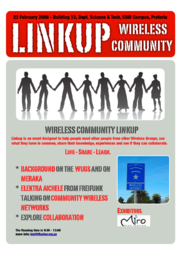
Linkup is an event designed to help people meet other people from other Wireless Groups, see what they have in common, share their knowledge and experiences and see if they can collaborate.
The following agenda is planned:
- Background on the WUGS and on the Meraka Institute
- Guest talk from Elektra Aichele from Freifunk talking about the wireless community network in Berlin
- Explore collaboration
Place: Building 53, Dept Science and Technology, CSIR Campus, Pretoria
Date: 23 February
Time: 9:30 AM - 13:00 AM
Contact: kmf@fischer.org.za
Presentations made by Meraka can be found here:
Overview of mesh networking at Meraka
Overview Freifunk mesh network
2 November 2007 - Building a Rural Wireless Mesh Network DIY Guide released
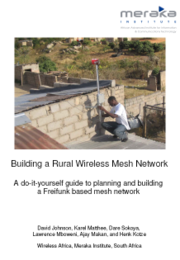
"Reliable, affordable and easy access to telecommunication services for all has been identified as key to social and economic development in Africa. Self-provisioning and community ownership of low cost, distributed infrastructure is becoming a viable alternative to increase the penetration of telecommunication services in rural Africa. The recent emergence of wireless mesh network technology (based on IEEE 802.11 a/b/g standards) can help to improve the delivery of telecommunication services in these regions."
The guide tries to simplfy the planning and building of a mesh network, using a step-by-step approach to setting up a infrastructure mesh node, or an access point using a Linksys WRT54gl and the Freifunk firmware or DD WRT firmware depending on the node type.
A pre-release version of the DIY mesh guide is now available. We invite researchers, wireless network implementors and communities to review the guide and provide us with feedback.
Access the DIY Mesh Guide
October 2007 - Wireless Africa featured in African Communications
"The Challenge of providing wireless connectivity across Africa is about researching the ways and means to develop sustainable informations and communications technology in developing countries..."
Read the full article download a .pdf of the article (177Kb)
25 October 2007 - Wireless Africa appears in iWeek
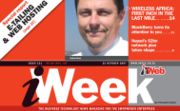
The CSIR's Wireless Africa project begins to make strides into mesh networking know-how that could help connect Africa's 850 million unconnected.
Africa has some 850 million broadband-unconnected people, and it is with these masses in mind that the CSIR launched its Wireless Africa project a few years ago.
Read the full article online at iWeek: First inch in the last mile
or download a .pdf of the article (1.1Mb)
17 August 2007 - Meraka Institute signs MoU with LinkNet of Zambia
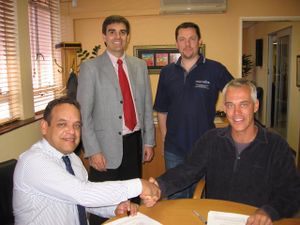
(Back) Karel Matthee and Kobus Roux (Meraka Institute)
The signing of a memorandum of understanding (MoU) between LinkNet Multi-Purpose Co-operative Society Limited of Zambia and the Meraka Institute on 17 August 2007 is another significant step towards the creation of low-cost, wireless connectivity in Africa. LinkNet has as its objective to establish internet communication facilities in rural communities in Zambia to further holistic empowerment and capacity building of institutions and rural people. The Meraka Institute is a South African national research centre managed by the CSIR.
Read full article: Meraka Institute signs MoU with LinkNet of Zambia
1 May 2007 - Wireless Africa roadmap process underway
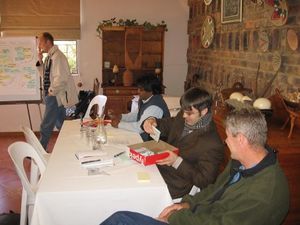
A number of workshops were hold with staff at Meraka to understand our vision and what our research, development and product offerings will be.
- The first workshop, held on the 18th of May 2007, helped us to understand where we've come from and what our vision is for the future. Our current vision statement is:
| Make a significant contribution to connecting 450 million people sustainably in rural Africa through wireless mesh and other technology with a community grown philosophy |
- The second workshop, held on the 8th of June 2007, helped us understand what our three main product offerings will be
- Africa mesh node (Multi radio node with customized hardware and specialized firmware)
- DIY mesh kit (Low cost single radio node available off the shelf with specialized firmware)
- WISP in a box (Bandwidth and user management tool which makes it simple for somebody to set up a wireless business)
- The third workshop, held on the 14th of June, was a follow up on the second workshop which tried to define the milestones needed to improve the functionality of each of these product offerings over a 3 year period (See link below for more detail).
The plan is to have a first draft of this road map by the end of July
More information can be found here: Wireless Africa Roadmap . We strongly urge other researchers in the field to comment on this roadmap
10 December 2006 - Prototype 1 of fully self-contained solar powered SA mesh node
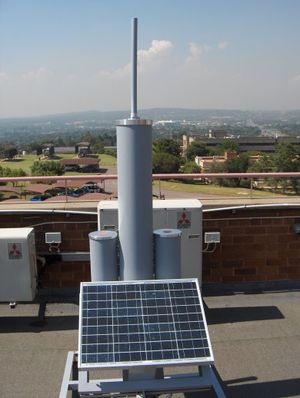
The first prototype of a multi antenna self-contained mesh node was unveiled in December 2006. This nodes operates on a 45W solar panel to power the embedded computer and three 802.11 radios. The backhaul mesh is built in the 5GHz band using 2 radios which can be switched through a matrix of 4 antennas. This allows a full duplex connection on the backhaul. The Switachable antenna matrix consists of 4 5GHz panel antennas placed at 90 degrees to each other within a weather proof cylinder. An intelligent switching algorithm is used to switch through the four antennas and locate the other mesh nodes in the network. Switching happens as soon as traffic needs to be routed between mesh nodes. A 2.4GHz band radio connected to an omni is used to connect clients to the mesh node.
More Information on the SA mesh node
1 October 2006 - Tin can connects rural home to outside world
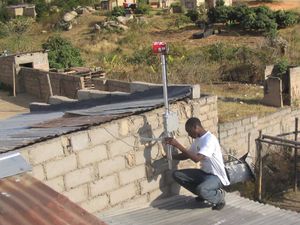
The Meraka Institute's first Cantenna installed in a rural setting was successfully mounted onto the house of Agnes Mdluli, a health worker from Peebles valley, near White River in Mpumalanga. This can-antenna is made from a metal can, such as a coffee tin, and a section of bicycle spoke soldered into a special connector which can connect to another point with a similar antenna up to 5km away. The project in Peebles Valley is one of 10 sub-projects in the First Mile First Inch (FMFI) project being funded by the International Development Research Centre (IDRC).
These small, self-constructed antennas, which are made from locally available material, are connected to a low-cost WiFi card plugged into a computer. A small wireless router is placed in a weatherproof casing on a pole to which several community members could connect and form a community mesh network. This mesh networking technology allows the wireless installations to automatically configure themselves to find the optimal routes through the network and very little configuration is needed to set them up.
More information can be found here: Mpumulanga Mesh and FMFI Mpumalanga Mesh
NEW: Quick getting started guide for setting up an outdoor mesh node
Please use the discussion tag above to comment and provide suggestions!
Please Email wa-admin(at)meraka.org.za if you wish to contribute or for further information.
